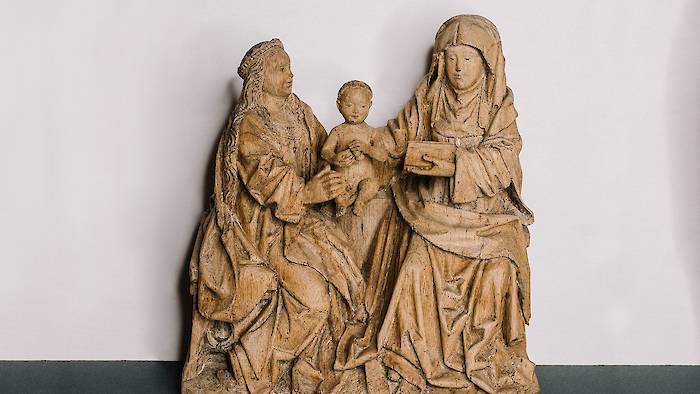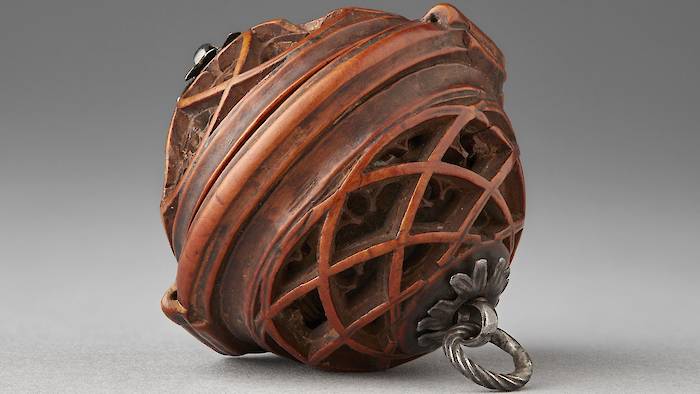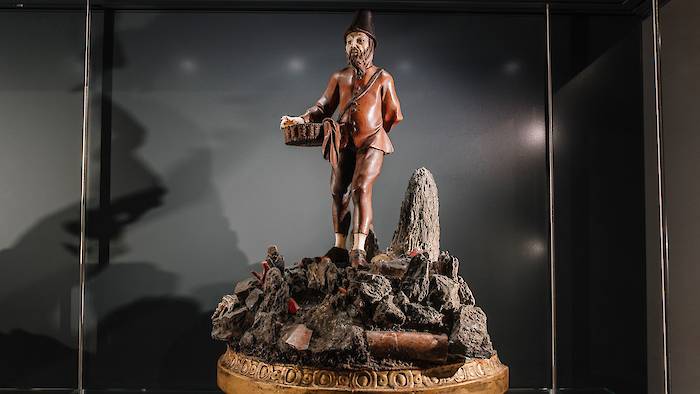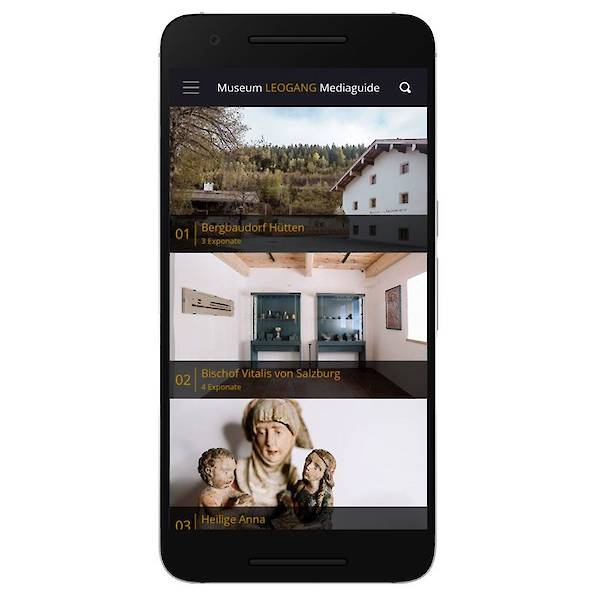Ein Auswahl unserer aktuellen Exponate
- Anna Selbdritt aus Köln
 Anna Selbdritt aus Köln
Anna Selbdritt aus KölnDie dritte Skulptur der Heiligen Anna Selbdritt, die als private Leihgabe im Bergbau- und Gotikmuseum Leogang zu sehen ist, stammt aus der Werkstatt des Meisters Tilman aus Köln. Tilman ist von 1487 bis 1515 in Köln archivarisch nachgewiesen und ist der bedeutendste Bildhauer und Bildschnitzer der Kölner Spätgotik.
Ursprünglich stand die Figurengruppe wohl im Zentrum eines kleinen Flügelaltars. Die Skulptur ist in Eichenholz ausgeführt, besitzt eine flache Rückseite und wurde zwischen den Jahren 1500 und 1510 gefertigt.
Charakteristisch für eine Skulptur aus der Werkstatt Tilmans sind die hohe Stirn Mariens und die unter der einfachen Krone herabfallenden, fein gewellten Haarsträhnen.
- Gebetsnuss der Maria von Burgund
 Gebetsnuss der Maria von Burgund
Gebetsnuss der Maria von BurgundGebetsnüsse oder Betnüsse sind nussförmige, kunstvoll geschnitzte Kapseln, die sich in zwei Hälften aufklappen lassen. Sie wurden vorwiegend vom späten 15. Jahrhundert bis zur Mitte des 16. Jahrhunderts als Anhänger am Rosenkranz oder an einer Schmuckkette getragen. Die deutsche Bezeichnung „Betnuss“ stammt allerdings aus dem späten 19. Jahrhundert und ist vermutlich eine wörtliche Übersetzung des französischen Begriffs „noix de prière“.
Der Ursprung der geschnitzten Kostbarkeiten wird in Flandern vermutet. So auch jener der vorliegenden Betnuss.
Sie stammt von Maria von Burgund, der Tochter Karls des Kühnen und Gattin Kaiser Maximilians I., und ist äußerst wertvoll. Es gibt nur wenige derartige Exemplare auf der Welt. Obwohl das seltene Stück lediglich ein paar Zentimeter misst, begeistert bereits die äußere Schicht des Kunstkammer-Gegenstandes. Eine delikate, durchbrochene Schnitzarbeit, ganz im Geschmack und Stil der Gotik. Im Inneren hält die Betnuss zwei filigrane, bedeutungsreiche Szenen bereit.
Klappt man das Schmuckstück auseinander, so zeigt die eine Hälfte ein kunstvoll geschnitztes Bild des Evangelisten Johannes, gemeinsam mit der Heiligen Katharina, die ein Schwert trägt, und der Heiligen Barbara.
Rechts im Hintergrund kann man den Turm erkennen, in den die Heilige Barbara der Legende nach von ihrem Vater gesperrt wurde, als dieser die Hinwendung der Tochter zum Christentum verhindern wollte. Der Turm besitzt drei Fenster als Symbol für die Heilige Dreifaltigkeit.
Die Heilige Barbara hat für Leogang als Schutzheilige der Bergleute eine besondere Bedeutung. Nach ihr wurde nicht nur ein Stollen benannt, der vierte Dezember, ihr Namenstag, galt den Leoganger Bergknappen als hoher Feiertag.
Die zweite Hälfte der Betnuss zeigt Maria von Burgund mit ihrem Gatten Kaiser Maximilian und dem Heiligen Georg.
- Buttenträger von Simon TrogerHöhepunkte barocker Bergmannskunst
 Buttenträger von Simon TrogerHöhepunkte barocker Bergmannskunst
Buttenträger von Simon TrogerHöhepunkte barocker BergmannskunstDie sogenannten Handsteine gelten als Höhepunkte barocker und spätbarocker Bergmannskunst. Handsteine sind besonders schön kristallisierte Mineral- oder Erzstufen, die unter Einbringung von Motiven aus dem bergmännischen Alltag künstlerisch bearbeitet und auf kostbaren Sockeln ausgestellt wurden. Von diesen seltenen Zeugnissen der Bergbaukunst ist weltweit kaum mehr als ein Dutzend erhalten.
Die bergmännische Schatz- und Wunderkammer im Bergbau- und Gotikmuseum Leogang präsentiert zwei Handsteine mit darauf angebrachten Figuren, sogenannten Buttenträgern, gefertigt im späten 18. Jahrhundert in der Tiroler Werkstatt von Simon Troger.
Zunächst eine große schreitende Figur mit Hut, das Gesicht aus Elfenbein oder Bein, also Knochen, gearbeitet, die auf einem aus Mineralien und Gesteinen zusammengesetzten Hügel angebracht ist. Zu erkennen sind Rauchquarz, Glimmerschiefer, Aktinolith (aus dem Griechischen für „Strahlstein“), aber auch ein kleines Amethyststück, polierte Karneole, Schnecken und Korallen. Der Handstein samt Figur sitzt auf einem vergoldeteten, aus Holz gefertigen, geschwungenen Sockel.
Ganz ähnlich der zweite Handstein aus der Werkstatt des Tiroler Meisters Simon Troger: auf einem aus Holz halbkreisförmig geschnitzten und vergoldeten Sockel ist ein aus Mineralien und Gesteinen zusammengefügter Hügel aufgebracht. Auch hier sind Rauchquarz, Marmorstückchen, ein sehr charakteristischer, spitz zulaufender Aktinolith, aber auch kleine polierte Karneole, Korallen und Muscheln zu erkennen. Darauf eine große Figur mit hohem Hut, Gesicht und Hände aus Elfenbein oder Bein, also Knochen, gefertigt.
Beide Handsteine mit Figuren sind Leihgaben des Bankhauses Spängler in Salzburg.
Unser Museum Audio Guide
Informationen zu allen unseren Exponaten?
In unserem öffentlich verfügbarem Museum´s Audio-Guide können Sie durch unsere Räume und Exponate stöbern.
